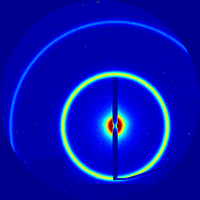SAXS
Small-angle x-ray scattering (SAXS) is a method to analyze the nanoscale structure of a sample by measuring the intensity of x-rays scattered as a function of angle.
The classic, stereotypical, application of SAXS is to study the size and shape of particles dispersed in solution (including biological macromolecules). In these cases, one typically reduces the 2D area detector image into a 1D curve (I vs. q), where the slope of the curve (and/or oscillations within it) encode information about the structure. SAXS can also be used to measure ordered nanoscale systems (e.g. nanoscale superlattices), where one observes sharp peaks in the scattering data. A variety of new techniques have been developed specifically for measurement of ordered nanostructures (GISAXS, CD-SAXS, GTSAXS, etc.).
See Also
- SAXS variants
- Grazing-incidence SAXS (GISAXS), useful for measuring thin-films.
- Rotational SAXS (CD-SAXS), for reconstructing reciprocal-space
